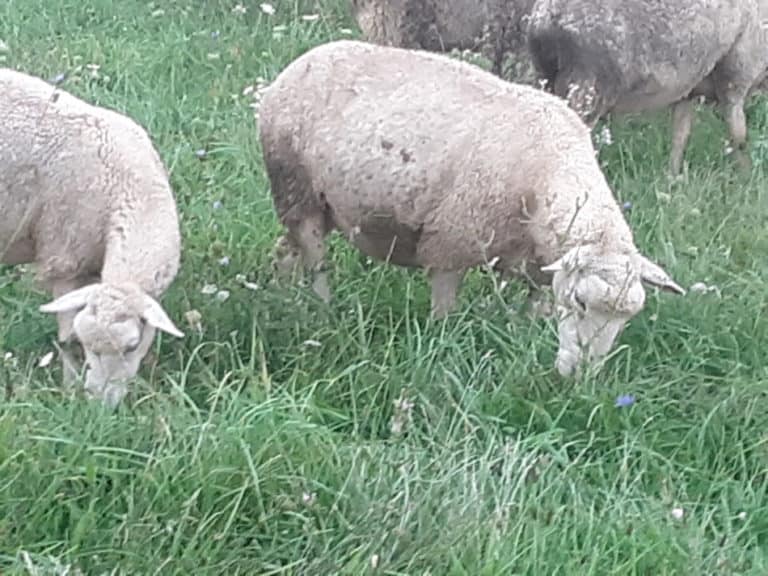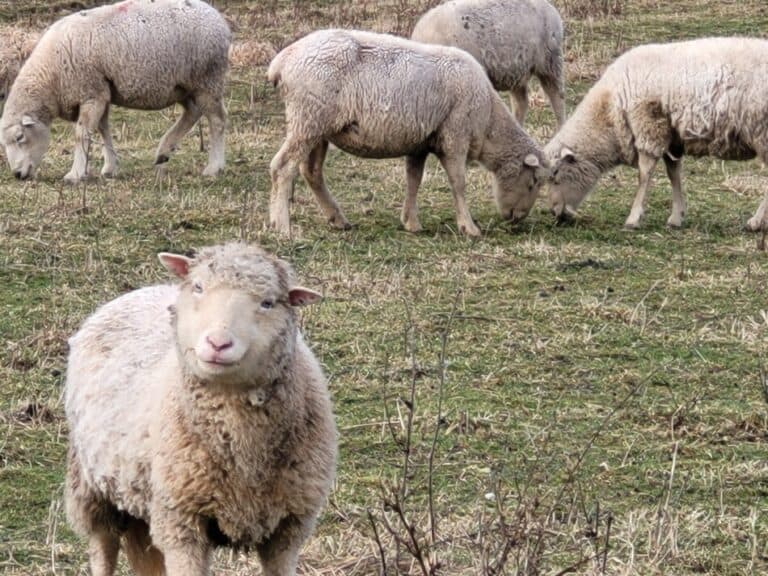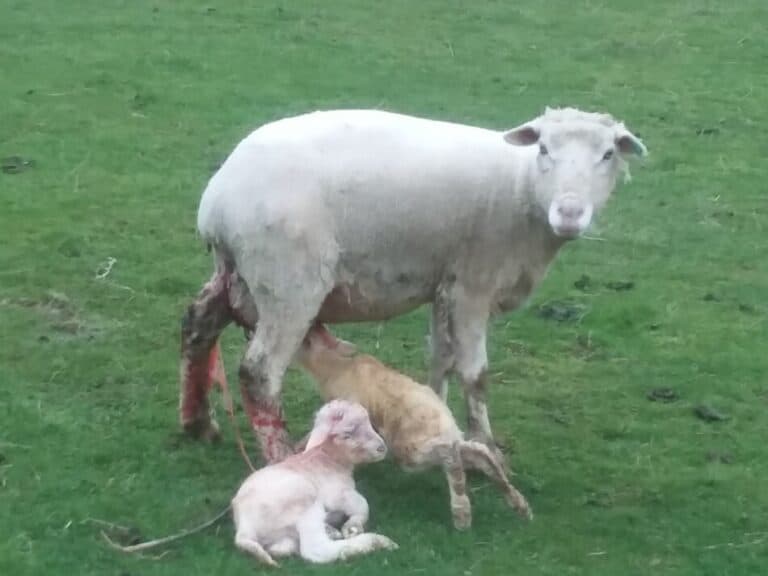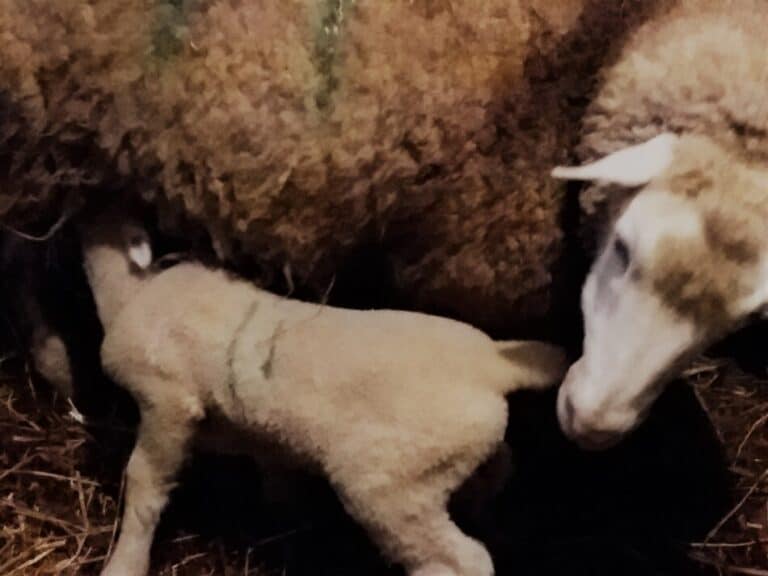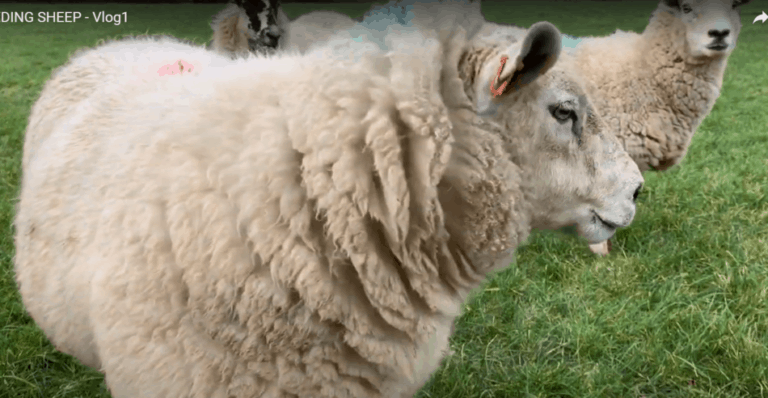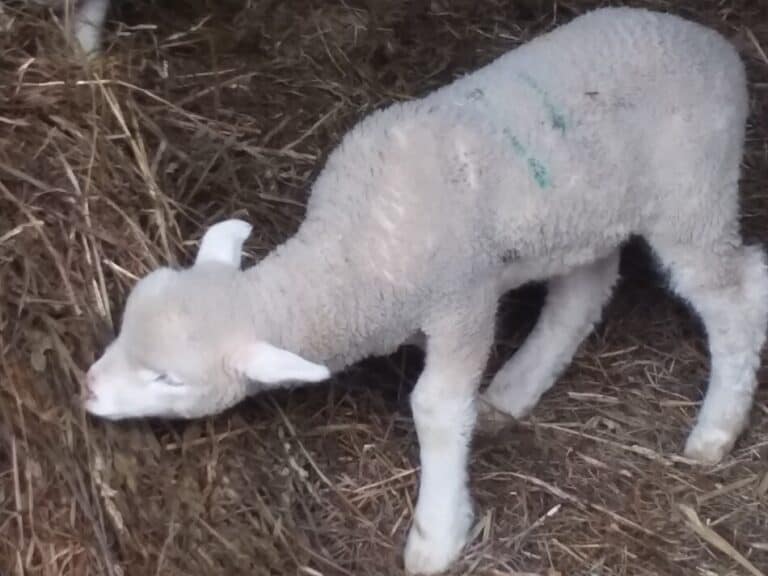Why Do Sheep Have Paint On Them?
When you look at a flock of sheep, you may notice that the sheep have paint on them. Sometimes it’s different colored paints, sometimes lines or numbers and sometimes the paint just looks like a blotch.
What’s going on, why do farmers put paint marks on sheep?
Farmers paint numbers on sheep for a quick to spray on and easy to see temporary identification that is on the sheep itself. Paint marks are used in situations where using ear tag numbers is difficult, slow or inconvenient.

Are Sheep Expensive To Raise? gives you the basic costs, like hay, that you’ll need to plan for when raising sheep.
Why do sheep have paint on them?
The sheep has paint on it’s back to show the shepherd that there is something special about this particular sheep that needs to be easily identified while standing at a distance.
It could be that she has a mark because she just got a some sort of medical treatment, she needs to be looked after more carefully than the rest or the paint mark shows other people, like other farm staff or the vet, what sheep needs attention.
Common reasons to put paint marks on sheep are:
- easier to see than a tag
- specific group
- mark as treated, for example: she was dewormed
- communicate with other help
- number to match with lamb
Easier to see than a tag
Paint marks are easier to see, especially from a distance, than an ear tag.
This is the main reason to use paint marks when working with sheep, it’s a quick way to see which sheep you need and which ones you don’t.
Part of a specific group of sheep
Using marking paint to spray a stripe or dot on a sheep is a great way to mark the sheep as part of a group when you do not have the sheep physically separated.
For instance, you may want to have your sheep pregnancy scanned, to see which ewes are carrying singles, twins or triplets.
In this case, you would mark the ewe with the color that goes with the number of lambs. This way you could put all of the ewes back together in one group for now and separate them off later.
At a later date, since you know how many lambs she is going to have, you can put her in a group with other ewes that have the same needs, like type of feed and eventually, lambing area.
We use colors to show any ewes that were added into the main group of sheep, to make it easy to see how they are adjusting.
We could write down tag numbers and keep a variety of lists, which we do but they are more difficult to use than an orange or red stripe down the back that is easy to see with a glance.

Mark the sheep as treated
Marking spray is also used to mark the individual sheep as treated when it is in a group. You want all the sheep to be treated, but only once! This could be for deworming, nutrient boluses, shots, etc.
Here’s the quandary: when your treatment is something that you can not see, how do you tell which sheep you have done and which sheep still need done?
Well, the easy way is to spray mark the ones you treat as you treat them, so you make sure that each sheep gets what she needs and does not get skipped over or double dosed.
This is especially helpful for small sheep farmers that do not have a dedicated set up for working (catching up flock for individual care), most small farms just use a pen, which gets confusing quickly.
As you can see on the lambs above, I tend to use dots on the backside, since the lambs move away from you when you approach them, so back marks are easier to see.
Since we do not want to risk confusing the mark from the last deworming, we switch colors or make a different mark than last time.
Communicate with other help
Another use of marking paint is to communicate with other help (other farm workers, vets, haulers) as to which sheep you (the person in charge of the sheep) are needing help with when you are not there.
It’s fairly common, especially at lambing time, for multiple people to be working with the sheep and that can get confusing fast.
Using paint marks helps a person who just got there know how to help both the sheep and the shepherd.
Paint number to match lambs
You may also see sheep with numbers painted on their back or sides, this is normally to match them up with their lambs.
Even if the ewes (sheep moms) have tags, all of the lambs are going to look similar, so how do you find the mom for a lost lamb? Painting numbers on the sides of both the ewe and the lambs makes this easier.
Believe it or not, lambing in the barn can make things more confusing rather than less confusing for the sheep and the shepherd.
When sheep are lambing in a barn, they are closer together than they would normally be if they were out on the pasture. This means you have more lamb and ewe confusion.
To make sure everyone stays with their lambs and doesn’t steal other lambs, you put on paint marks.
Do all shepherds use paint on sheep?
All shepherds do not use paint to mark their sheep. Paint marks are helpful to most flocks in specific situations, but not for all flocks and definitely not for all situations!
For instance, the larger flocks or mobs of sheep with thousands of head would need too much paint to individually mark all of the sheep. But they would probably keep a can handy for a special case.
Also, folks with just a handful of sheep probably are not using paint marks either, especially if the sheep are tagged or different colored. These sheep are already easy to tell apart, the spray mark is not needed.
We use spray marks on our sheep to help us identify from a short distance anyone that got special treatment, like an extra deworming or needs checked back up on for a few days, rather than having to catch the sheep to read some of the smaller ear tags.
The challenge for us, as shepherds, is that all of our sheep look similar.
There are differences between individuals but in a flock of 200 I would say there are at least 10 that look similar no matter what you are looking for.
If I need one of those 10, which one is it? The paint marks fix this problem for us.
The marks are less stressful for the sheep than catching her repeatedly and allow us to catch only the one we need if it turns out that she does need more attention.
The paint marks are fast to put on and easy to see when the sheep are all in a group.
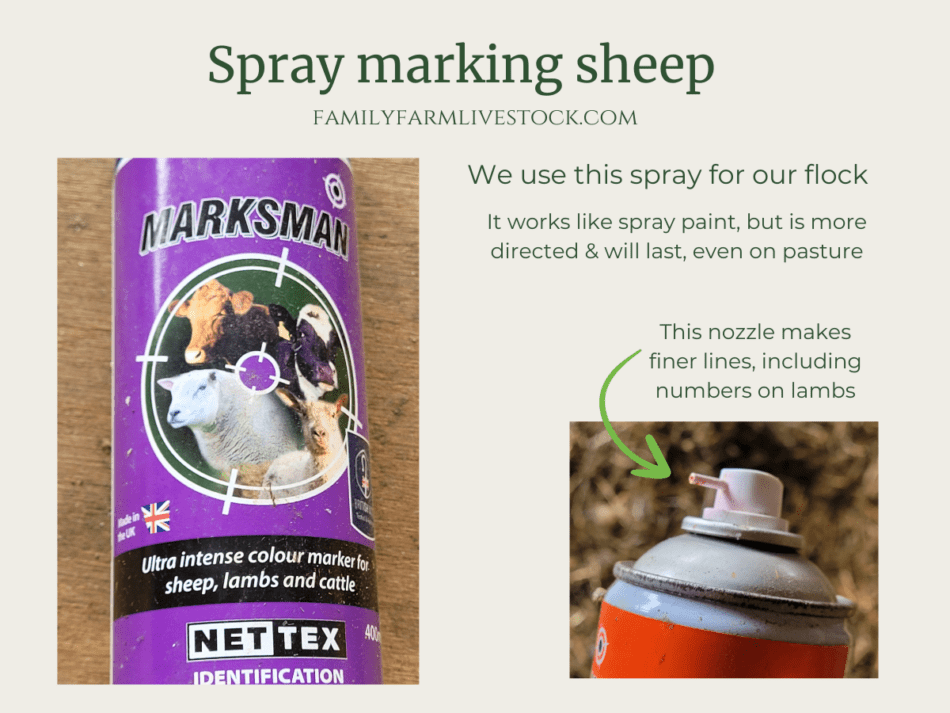
What is used to paint the sheep?
There are a few different ways to put colored marks on sheep, spray marking and ram harnesses are the most common in my area.
Spray marking is done with an aerosol can that looks like spray paint, but it is actually a special formulation that is scourable, meaning it will wash out of the wool.
Livestock spray marking paint has a nozzle that allows for fairly precise writing, like for numbers or letters, rather than just spraying an area.
We use Marksman out of the U.K. We love this stuff and have multiple colors. While I’ll have to admit, this stuff is not cheap, it works so well that it’s definitely worth the cost and can be used on other stock, too.
There are other brands of spray marking paint available, but some have mixed (read poor) reviews. Unless you know someone who has success using another brand, stick to Marksman.
Marksman Sheep Marking Spray is made by Net-Tex at Net-tex.co.uk, since this is a British company and we are in the U.S. we get our cans from a local feed store that carries these products.
Ram breeding harness marks are the other common reason to see colored marks on sheep.
Some shepherds put a harness with a crayon between the front legs of the ram on each ram for the breeding season. When the ram breeds a ewe, the crayon rubs some color on her back.
Ram breeding harness marks look different from spray marks, with the breeding harness marks the color is normally all over the backside of the ewe, making more of of blotch. Spray marks can be any shape.
